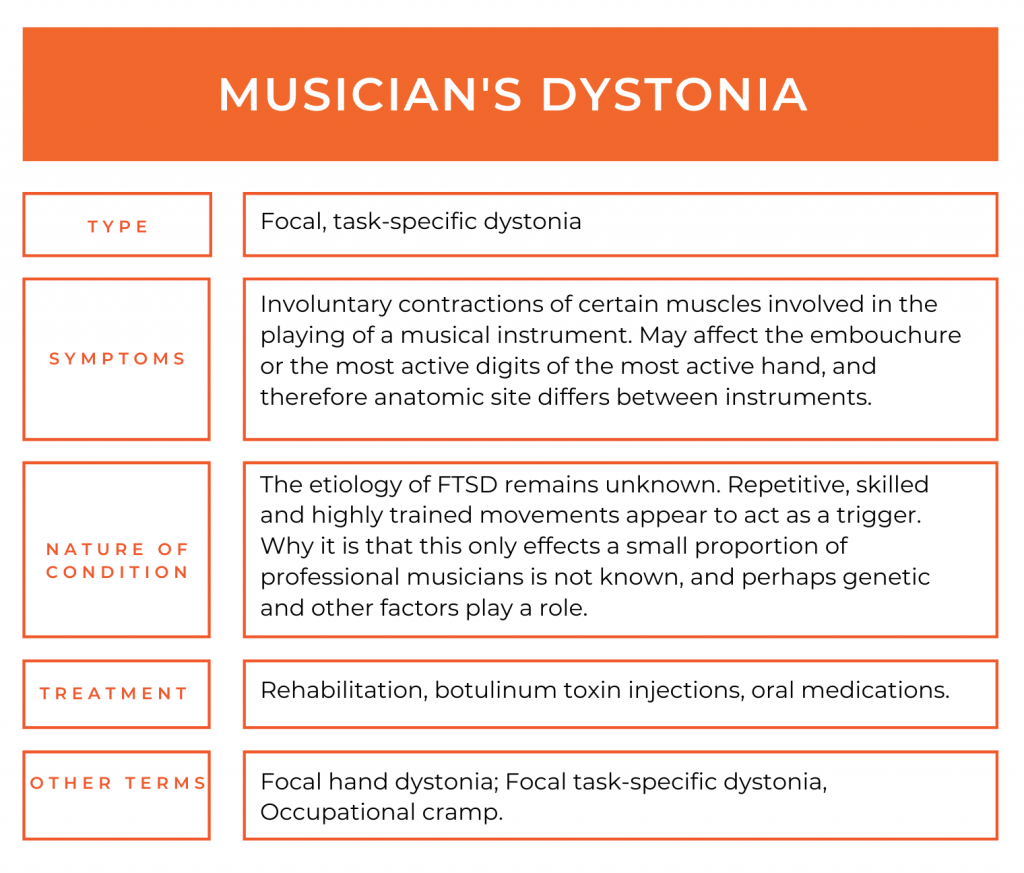 Musician’s Dystonia PDF Download
Musician’s Dystonia PDF Download
Symptoms:
The main symptoms are of involuntary abnormal postures +/- tremor that occur in particular muscles when playing the musical instrument. It is more common for pianists to develop symptoms in their right hand (the hand with the highest technical demands) whereas string players more often develop symptoms in the left hand. Woodwind players whose ability requires both hands, face and mouth are affected in those specific areas. Brass players are more often affected in the muscles around the mouth (embouchure). Pain is not usually associated with musician’s dystonia.
Causes:
The exact causes of focal task-specific dystonia are unknown. Repetitive, skilled and highly trained movements appear to act as a trigger. Why it is that this only effects a small proportion of professional musicians is not known, and perhaps genetic and other factors play a role.
Diagnosis:
Your doctor will ask about your medical history, mainly :
- The age of onset
- The area of the body affected
- Is the condition getting worse?
- Are there any other associated clinical problems?
The doctor will also perform an examination of the affected body part(s). For some patients, blood tests, electromyography or brain scanning may be recommended. However, it may not be possible for your doctor to find an exact cause.
Treatment:
Rehabilitation – This is the mainstay of treatment for musician’s focal dystonia. This can involve retraining of sensory discrimination, retraining of individual movements and identification and treatment of unhelpful secondary postures that have developed to compensate for the original problem.
Botulinum Toxin – Botulinum toxin injections can be effective in the treatment of focal dystonia in musicians. Botulinum toxin injections temporarily weaken muscles to decrease the contractions and usually need to be injected every 3 to 4 months. In musicians, because of the very fine control needed to play to a high standard, it can be difficult to get the balance between controlling the movements and causing temporary weakness.
Oral Medication – The most commonly used medications include: anticholinergics (e.g. Artane -trihexyphenidyl), benzodiazepines, baclofen, muscle relaxants. Medications often are given on a trial-and-error basis to balance between the benefits and potential side effects (dry mouth, drowsiness, anxiety and difficulty urinating).
Surgery – There is some very limited evidence that brain surgery might help people with musician’s focal dystonia. The surgical evidence currently is for a lesion operation in the thalamus. However, evidence regarding long-term outcome is limited.
